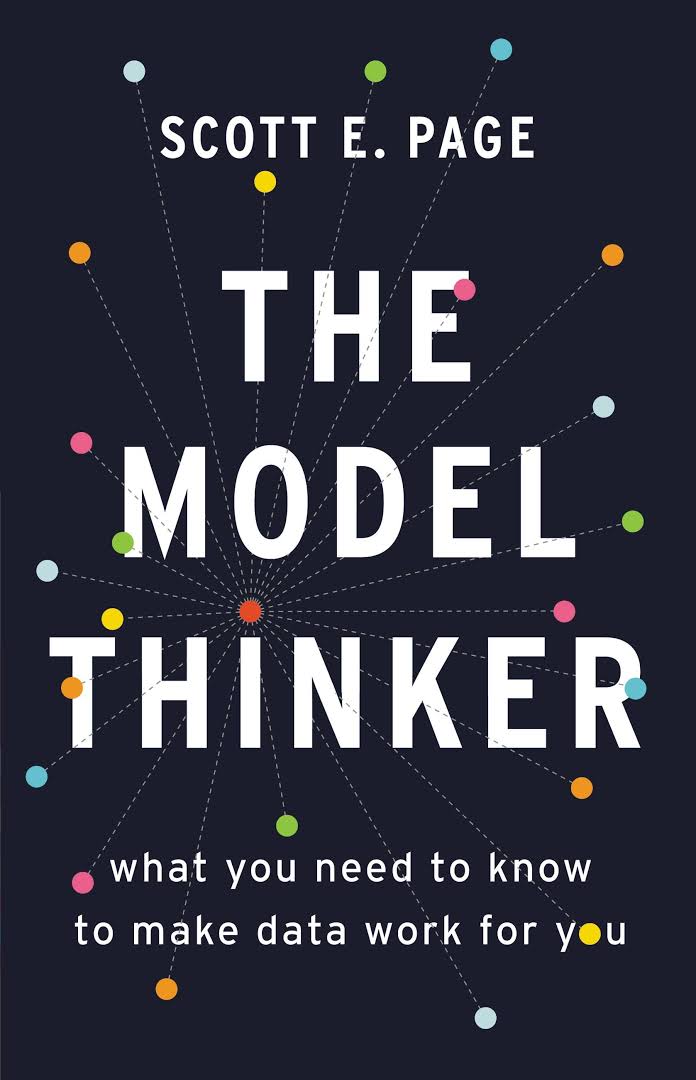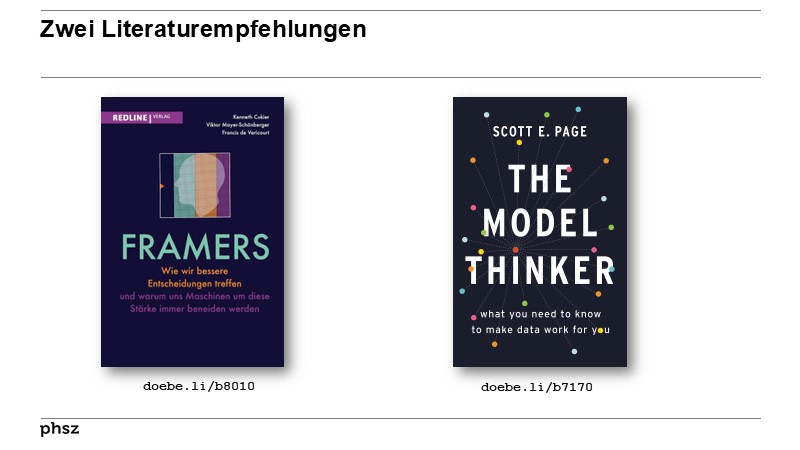 Zusammenfassungen
Zusammenfassungen
 This is a book about models. It describes dozens of models in straightforward language and explains how to apply them. Models are formal structures represented in mathematics and diagrams that help us to understand the world. Mastery of models improves your ability to reason, explain, design, communicate, act, predict, and explore.
This is a book about models. It describes dozens of models in straightforward language and explains how to apply them. Models are formal structures represented in mathematics and diagrams that help us to understand the world. Mastery of models improves your ability to reason, explain, design, communicate, act, predict, and explore. From the stock market to genomics laboratories, census figures to marketing email blasts, we are awash with data. But as anyone who has ever opened up a spreadsheet packed with seemingly infinite lines of data knows, numbers aren't enough: we need to know how to make those numbers talk. InThe Model Thinker, social scientist Scott E. Page shows us the mathematical, statistical, and computational models--from linear regression to random walks and far beyond--that can turn anyone into a genius. At the core of the book is Page's "many-model paradigm," which shows the reader how to apply multiple models to organize the data, leading to wiser choices, more accurate predictions, and more robust designs.The Model Thinkerprovides a toolkit for business people, students, scientists, pollsters, and bloggers to make them better, clearer thinkers, able to leverage data and information to their advantage.
From the stock market to genomics laboratories, census figures to marketing email blasts, we are awash with data. But as anyone who has ever opened up a spreadsheet packed with seemingly infinite lines of data knows, numbers aren't enough: we need to know how to make those numbers talk. InThe Model Thinker, social scientist Scott E. Page shows us the mathematical, statistical, and computational models--from linear regression to random walks and far beyond--that can turn anyone into a genius. At the core of the book is Page's "many-model paradigm," which shows the reader how to apply multiple models to organize the data, leading to wiser choices, more accurate predictions, and more robust designs.The Model Thinkerprovides a toolkit for business people, students, scientists, pollsters, and bloggers to make them better, clearer thinkers, able to leverage data and information to their advantage. To summarize, we live in a time awash in information and data. The same technological advances generating those data shrink time and distance. They make economic, political, and social actors more agile, capable of responding to economic and political events in an instant. They also increase connectedness, and therefore complexity. We face a technologically induced paradox: we know more about the world, but that world is more complex. In light of that complexity, any single model will be more likely to fail. We should not though abandon models. To the contrary, we should privilege logical coherence over intuition and double, triple, and even quadruple down on models and become many-model thinkers.
To summarize, we live in a time awash in information and data. The same technological advances generating those data shrink time and distance. They make economic, political, and social actors more agile, capable of responding to economic and political events in an instant. They also increase connectedness, and therefore complexity. We face a technologically induced paradox: we know more about the world, but that world is more complex. In light of that complexity, any single model will be more likely to fail. We should not though abandon models. To the contrary, we should privilege logical coherence over intuition and double, triple, and even quadruple down on models and become many-model thinkers.
Becoming a many-model thinker requires learning multiple models of which we gain a working knowledge; we need to understand the formal descriptions of the models and know how to apply them. We need not be experts. Hence, this book balances accessibility and depth. It can function both as a resource and as a guide. The formal descriptions are isolated in stand-alone boxes. It avoids line after line of equations, which overwhelm even the most dedicated readers. The formalism that remains should be engaged and absorbed. Modeling is a craft, mastered through engagement; it is not a spectator sport. It requires deliberate practice. In modeling, mathematics and logic play the role of an expert coach. They correct our flaws.
The remainder of the book is organized as follows: Chapters 2 and 3 motivate the many-model approach. Chapter 4 discusses the challenges of modeling people. The next twenty or so chapters cover individual models or classes of models. By considering one type of model at a time, we can better wrap our heads around ist assumptions, implications, and applications. This structure also means that we can pull the book from our bookshelves or open it in our browsers and find self-contained analyses of linear models, prediction models, network models, contagion models, and models of long-tailed distributions, learning, spatial competition, consumer preferences, path dependence, innovation, and economic growth. Interspersed throughout the chapters are applications of many-model thinking to a variety of problems and issues. The book concludes with two deeper dives into the opioid epidemic and income inequality.
 Kapitel
Kapitel 
- 1. The Many-Model Thinker
- 2. Why model?
- 3. The Science of Many Models
- 4. Modeling Human Actors
- 5. Normal Distributions: The Bell Curve
 Dieses Buch erwähnt ...
Dieses Buch erwähnt ...
 Personen KB IB clear | Daron Acemoglu , Chris Anderson , David Autor , A. L. Bleloch , Peter Drucker , Stephen J. Dubner , Claudia Goldin , Mark Granovetter , Garrett Hardin , Steven D. Levitt , Deirdre N. McCloskey , Cathy O’Neil , James A. Robinson , Nate Silver , Karl A. Smith , A. M. Starfield , John D. Sterman , Nassim Nicholas Taleb , Duncan J. Watts , Stephen Wolfram , Stephen Thomas Ziliak | |||||||||||||||||||||||||||||||||||||||||||||||||||||||||||||||||||||||||||||||||||||||||||||||||||||||||||||||||||||||||||||||||||||||
 Begriffe KB IB clear | Analogieanalogy
,  big data big data big data
, big data
,  Categorization Categorization Categorization
, Categorization
,  Daten Daten data
, GefangenendilemmaPrisoner's dilemma
, Informationinformation
, Intuition
, data
, GefangenendilemmaPrisoner's dilemma
, Informationinformation
, Intuition
,  Klassifikation
, Klassifikation
,  knowledge worker knowledge worker knowledge worker
, Komplexitätcomplexity
, knowledge worker
, Komplexitätcomplexity
,  Mathematik Mathematik mathematics
, mathematics
,  Modelle Modelle model
, Ockhams RazorOckhams Razor
, Quantitative Modelle
, Regression
, model
, Ockhams RazorOckhams Razor
, Quantitative Modelle
, Regression
,  Statistik Statistik statistics
, statistics
,  Weisheit Weisheit wisdom
, wisdom
,  Wissen
, Wissenstreppe Wissen
, Wissenstreppe
| |||||||||||||||||||||||||||||||||||||||||||||||||||||||||||||||||||||||||||||||||||||||||||||||||||||||||||||||||||||||||||||||||||||||
 Bücher |
| |||||||||||||||||||||||||||||||||||||||||||||||||||||||||||||||||||||||||||||||||||||||||||||||||||||||||||||||||||||||||||||||||||||||
 Texte |
|
 Dieses Buch erwähnt vermutlich nicht ...
Dieses Buch erwähnt vermutlich nicht ... 
 Nicht erwähnte Begriffe | Wissensmanagement |
 Tagcloud
Tagcloud
 Vorträge von Beat mit Bezug
Vorträge von Beat mit Bezug
 Zitationsgraph
Zitationsgraph
 Zitationsgraph (Beta-Test mit vis.js)
Zitationsgraph (Beta-Test mit vis.js)
 Zeitleiste
Zeitleiste
 1 Erwähnungen
1 Erwähnungen 
- Framers - Human Advantage in an Age of Technology and Turmoil (Kenneth Cukier, Viktor Mayer-Schönberger, Francis de Véricourt) (2021)


- 7. learning
 Volltext dieses Dokuments
Volltext dieses Dokuments
 | The Model Thinker: Gesamtes Buch als Volltext ( : 11573 kByte) : 11573 kByte) |
 | The Model Thinker: Gesamtes Buch als Volltext ( : 11573 kByte) : 11573 kByte) |
 Standorte
Standorte 
 Bibliographisches
Bibliographisches 
 Beat und dieses Buch
Beat und dieses Buch
Beat hat dieses Buch während seiner Zeit am Institut für Medien und Schule (IMS) ins Biblionetz aufgenommen. Beat besitzt ein physisches und ein digitales Exemplar. (das er aber aus Urheberrechtsgründen nicht einfach weitergeben darf). Es gibt bisher nur wenige Objekte im Biblionetz, die dieses Werk zitieren. Beat hat dieses Buch auch schon in Vorträgen erwähnt.




























 Biblionetz-History
Biblionetz-History